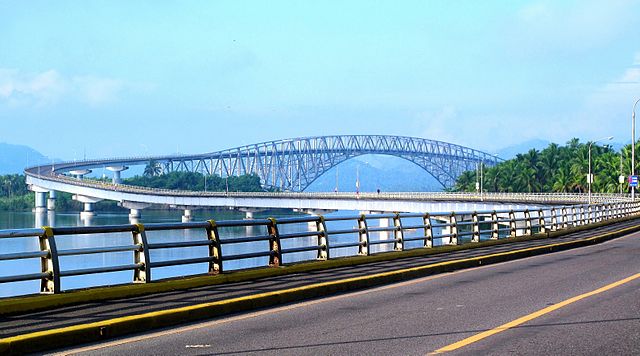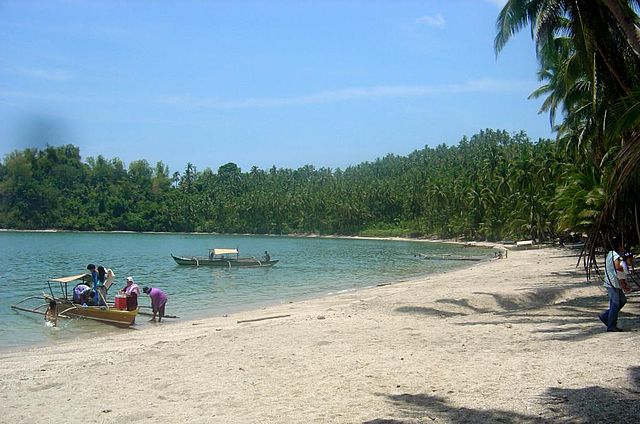Fabulous Philippines > Samar
Share this page:
Samar is an island located in the eastern part of the Visayas (central Philippines) and lies between the island of Luzon to the north and the island of Leyte to the south.
Samar is linked to the island of Leyte by the 2 km long San Juanico Bridge across the San Juanico Strait. This bridge is regarded as one of the most beautiful in Southeast Asia.

The San Juanico Bridge between the islands of Leyte and Samar (viewed from the Samar side).
Photo: Morten Naerboe, 2009.
The island of Samar is largely undeveloped with numerous beautiful beaches on the east coast and with dense tropical jungle and many creeks in the hilly interior.
Samar produces some rice, maize and potatoes and is an important centre for abaca (plant whose fibres are used in twines, ropes, paper products, etc.) and coconuts (Borongan on the eastern coast produces a lot of copra). Logging and sawmilling, are important on the eastern coast.
The people of Samar call themselves Waray and speak the Waray-Waray language.
Administratively, the island of Samare is divided into three provinces: Northern Samar, Western Samar and Eastern Samar.
Western Samar
Catbalogan, the provincial capital of Western Samar, is a commercial, industrial and fishing centre.
The wonderful Sohoton National Park is a wilderness of limestone caves, gorges, falls, and underground rivers.
This national park is Western Samar's top tourist attraction. It may most conveniently be reached from Basey in southwest Samar or from Tacloban, Leyte.
Entering this national park necessitates a 30 km boat trip upriver. Once in the park, there are a number of features you should see:
• Panhulugan Island: the park's largest cave with many stalagmite and stalactite formations that will sparkle and glitter under the rays of your electric torch (DON'T forget to take your electric torch as it is totally dark inside the cave)
• Sohoton Cave: this cave affords a view over a rock formation forming a natural stone bridge across a gorge.
• Bugusan III Cave: this cave includes an underground stream.
In recent years prehistoric artefacts (including burial jars and decorated human teeth) and Chinese porcelain from the Sung and Ming eras have been found in the above-mentioned caves.
During the Philippine-American War and the Second World War Filipino guerillas used these caves as hideouts.

Panapukan Beach, Tarangnan, Western Samar
Photo: Mjdspider
Eastern Samar
The wild coast of Eastern Samar between the towns of Borongan and Guiuan is becoming popular with surfers.
Cataman: This town is a provincial capital, a university town, and a commercial centre.
Borongan: Important source of copra.
Guiuan:
-- Golden cowrie (Conus gloriamaris) shells may be found along the coasts around this town.
-- The Church of the Immaculate Conception, a fine 16th century church with hand-carved doors, altars with carved ivory saints, and old santos (religious symbols, particularly wooden representations of the saints). This church was designed to double as a place of worship and as a fortress with a bulwark located in each corner.
-- White Russian refugees fled here from Communist China in 1945-51. Some of their descendants still remain.
-- Large airfields, now deserted, from where the Americans launched attacks on the Japanese during the Second World War.
Homonhon Island, located two hours by public bangka (boat) from the shore of Guiuan. It was on this island that Ferdinand Magellan is believed to have made his first landfall in the Philippine Archipelago on 16 March 1521.
Magellan's diarist noted that the island was a "watering place of good signs". These days it is a quiet island with come beautiful coconut palm lined beaches and waterfalls.
At the point where Magellan is said to have landed you may see a marker erected by the Philippine Historical Committee.
On 25 March 1521 Magellan sailed on to the island of Limasawa (located off the southern tip of the island of Leyte) where it is believed the first Catholic mass in the Philippines was held on 31 March 1521. After that, Magellan sailed to Cebu.
Share this page:
Author: David Paul Wagner
(David Paul Wagner on Google+)
|